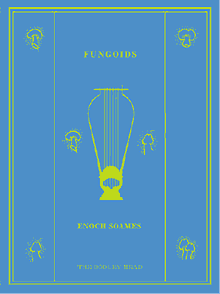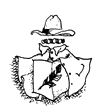 |
| Reputed variant
of the front cover of John Lane's edition of Fungoids |
Strange Growths
An investigation into the history and present location
of four copies of “fungoids”
Hinda Rose of Maggs Brothers, London.
As many book collectors are aware, on 3 June 1997 the
British Library commemorated the centenary of the mysterious disappearance
of Enoch Soames, arguably the most significant English poet of the 1890s.
His short and tragic life was recorded by Max Beerbohm in a poignant
chapter of Seven Men (1919). The crowning masterpiece of Soames’s
literary career was Fungoids, published in 1894.
The fact that no copy of the first (and only)
edition of Fungoids is to be found in any known library has led to the
general assumption that none has survived. It had long been our ambition
at Maggs Brothers to locate and present a copy to the British Library
on the occasion of the centenary of Soames’s disappearance, and
although our hopes were frustrated, and the time and considerable expense
involved in our research led to no definite result, we nevertheless
feel that our lengthy investigations into the history of four known
copies—the Preston Telegraph copy, the Widener copy, the Sun-Yat-Sen
copy and the Mrs. Robinson copy—give grounds for continuing hope.
1 The Preston Telegraph copy.
Enoch Soames’s first biographer Max Beerbohm informs us that Fungoids
received its only review in the Preston Telegraph. The daring modernity
of the verse proved somewhat daunting to the paper’s literary-
critic-cum-gardening-correspondent Ebenezer Capstraw, whose lukewarm
review singularly failed to penetrate the virtual reality, if one may
so call it, of Soames’s semiotically-described parallel universes.
In accordance with long-established tradition, Capstraw immediately
sold the volume to a Manchester second-hand bookshop, where it was bought
some years later by C. P. Scott, the editor of the Manchester Guardian.
Scott, whose fine mind enabled him to form a true estimate of Soames’s
worth, intended to devote a long article to the now-vanished poet. Had
he done so, Soames’s fame would doubtless have been assured, but
unfortunately the outbreak of the Boer War and the Manchester Guardian’s
campaign of opposition to it (the War, that is) forced a severe curtailment
of the paper’s literary pages. Scott’s copy of Fungoids has
not been seen since his death in 1932; however we are assiduous in our
visits to northern bookfairs and booksellers in the Manchester area,
and even after many years of false trails and disappointment we are
convinced that this remains a promising line of enquiry.
2 The Widener copy.
While it has long been known that Sangorski’s finest binding, of
the Rubaiyat, was lost with the Titanic in 1912, it is less well-known
that another exquisite Sangorski binding of Fungoids was also on board.
Young Harry Widener had, on a whim, picked up a second-hand copy in
the Charing Cross Road, without ever having heard of the author. He
was particularly impressed by the title poem of the collection, which
begins, with the now celebrated lines:
The honey-laden mushroom cringes By Byzantium’s
violet fringes.
Having commissioned an elaborate binding for the volume, Widener
collected it from Sangorski the day before he boarded the Titanic at Southampton
for his return to America. Neither he nor his precious volume was among
the survivors, although his grieving family hoped for years that the book
might be salvaged and placed in the Harvard library they had built in
his memory. Before the recent exhibition at the National Maritime Museum
of objects recovered from the fated ship, there was a rumour—alas
unfounded—that part of the binding had indeed been salvaged. Although
the search has, so far, been fruitless, excavations of the sea-bed continue,
closely monitored by the distinguished marine biologist Dr. Christine
Maggs.
3 The Sun-Yat-Sen copy.
We were informed some years ago by a client of ours, a prominent Hong
Kong businessman with excellent mainland connections, that a copy of
Fungoids was in the possession of China’s then Paramount Leader,
Deng Xiao Ping. We were naturally sceptical at first, but extensive
personal investigations in Soho and Beijing, undertaken not without
risk, have given credence to what might, at first, seem an unlikely
sequence of events. Sun Yat Sen, the father of Chinese nationalism,
was living in exile in London in 1896. Young, charming and educated,
he had the entrée to both fashionable and intellectual society
and was introduced to Enoch Soames by Max Beerbohm. It was in the course
of a convivial evening in Soho, in the company of Leonard Smithers and
Frank Harris, that Soames gave Sun Yat Sen an inscribed presentation
copy of Fungoids. The volume was in Sun’s pocket when he was kidnapped
in the street two days later by agents of the Chinese Imperial Government
and held prisoner in the Chinese legation in London. International outcry
and the representations of the Foreign Office led to his release after
ten days; however, not all his possessions were returned to him, and
his copy of Fungoids was forwarded to the aged Dowager Empress Tzu Hsi
in Beijing. It was inher- ited by the last Emperor “Henry”
Pu Yi, and was one of the few belongings he was able to keep with him
in his last years as a gardener. Shortly before his death, Pu Yi gave
the volume to Mao Tse Tung, in a futile attempt to gain more favourable
living conditions.
Fungoids was greatly prized by Mao, who, as
a poet himself, was able to appreciate the delicate, virtually impenetrable
nuances of the English writer. However an animated ideological debate
broke out as to whether Soames was to be regarded as a petit-bourgeois
deviationist running-dog, or as a heroic brain-worker who put his talents
at the disposal of the masses. As we now know, Mao’s more favourable
view prevailed. A casualty of the argument was the former State President
Li Xiao Chi, who remained blind to Soames’s merits and apparently
paid with his life for his obtuseness.
In a celebrated episode of the Cultural Revolution
a heroic Red Guard saved an armoured truck from rolling over a cliff
by blocking it with his body: the truck, once thought only to have contained
copies of the Little Red Book, is now known to have been transporting
Mao’s copy of Fungoids to his summer residence. Deng Xiao Ping,
as the inheritor of Mao’s power, also inherited his library, which
we believe has recently passed to Jiang Zemin, now the President of
China. Approaches have been made to the Chinese Government to see if
a purchase or extended loan of this important copy of Fungoids might
be possible, and we are awaiting a reply.
4 The Mrs. Robinson copy.
Mrs. Robinson (always known only by her surname) was a celebrated fortune-teller
in the 1880s and ’90s who numbered Oscar Wilde and the young Winston
Churchill among the clients who visited her comfortable consulting rooms
in Mortimer Street. Her prognostications were generally optimistic,
which probably accounts for her considerable popularity. Enoch Soames
is known to have consulted her shortly after the publication of Fungoids
in early 1894 and received a favourable prediction for its success.
He gave her on this occasion a copy inscribed to “The Sibyl of
Mortimer Street” (as Mrs. Robinson was generally called). Unfortunately
the fierce symbolism of the verses was somewhat beyond her, and when,
some years later, a client idly picked up the volume she had left on
an occasional table in her consulting room, she willingly gave it to
him. Thus it was that the young Winston Churchill had a copy of Fungoids
among his books when he sailed to South Africa in 1899 to report the
Boer War for the Morning Post. It was with him when he was captured
by the Boers in the armoured train ambush on 15 November, but he inadvertently
left it behind in his Pretoria prison cell when he achieved his celebrated
escape on 12 December. Our research indicates that it was taken home
by one of the prison guards and may now be in the possession of one
of that guard’s numerous descendants. We are employing the leading
firm of South African private detectives to pursue this enquiry on our
behalf, and await their next report with impatience.
* * *
As we are going to press, we have received a tantalising report from
California that the original proofs for Fungoids may have been found
in the botanical section of the Huntington Library. It seems that the
great Dr. Rosenbach himself sold them to Henry Huntington, founder of
the library, art gallery and gardens which bear his name, and that because
of their title they were placed with the botanical books and manuscripts.
It can be imagined with what anxious anticipation we await confirmation
of this report.
Our researches have revealed for each of these
copies a fate hardly less dramatic and astonishing than that which befell
Enoch Soames himself. It is certainly to be hoped that with four parallel
investigations continuing, one at least of these volumes may be found
in time for the bicentennial exhibition, which will open on 3 June 2097.
|



